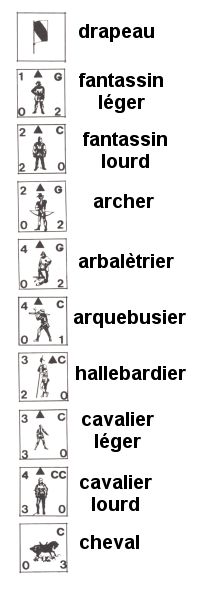

The game
Landsknecht is a tactical wargame that take place during the 16th Century (Renaissance).
There are not many games on this period. The game itself is a tactical game - one counter = one man - in a design similar to the "Cry Havoc" series, but unfortunately with counters less beautiful.
This is a game with gradual difficulty, with scenarios played with more and more counters and more and more rules options.
The illustration
The illustration, signed MDC, show well the military context: a period with a coming back of infantry armed with spears that are 3m50 high, using a formation similar to the Roman phalanx one.
They are playing dice on a drum. The style is of course renaissance but the theme looks like Achille and Ajax playing dice.

Opening of the box
The box contains the map, 4 sheet of 160 counters and 5 time cards, the rules, one sheet with combat tables (cut into three parts - one in French, one in German, one in Italian) and 2 dice.

The map
The map represents a small battlefield. One hexagon = 2 meters. Some topographic elements are only used with the advanced rules of the game. With the basic game, the map is considered as a plain.

The counters
The counters are printed on 4 basic colours and are double sided. The second face is printed on a lighter colour background and the counters have a smaller value (wounded soldier). the number in the top left is the purchasing value and moral. The letter in the top right indicate the armour (G leader, C partial armour, CC full armour). The number in the bottom left is the ability value. In the bottom right is the movement capacity. The top triangle indicated the direction in which the soldier is looking at. The horsemen are placed on horse counters.




The rules
The rulebook contains 15 pages in three languages (Italian, German, French) and 4 pages of examples.
The goal of the game is to kill the enemies or take their flag.
In the beginning of each turn, each player take a "time card". The one with the smaller number starts. for each of the player, the movement factor of each counter is increased with the "time card" value. After movement, the player solve the combats. The attacked counters can do a counterattack.
Two scenarios are proposed for the basic game: 1 combat with two armies of 18 counters (including 1 flag), A combat with purchase of an army for a 30 point value (without throwing weapons).
In the advanced game are managed the horseman/horse counters, the terrain differences and the firing, Between two firing, the counter have two wait without moving during several turns to rearm (1 for the bowmen, 3 for the crossbowmen and 4 for the arquebusiers). The small counters with numbers are used to countdown the rearmement turns. There is a global moral calculation in the beginning of each turn that can declare a defeat by routing.
Two scenarios are proposed for the advanced game: "the bridge (30 counters with 50% with firing capabilities against 50 counters) and "the global confrontation" with purchase of two armies (with at least 70 points)
Some price (2004-2006):
This game is unusual. it was published in a small amount.
| N° EBAY | Price EBAY | Country | Date | Remarks |
| 5208432650 | EUR 81,50 | Germany | 20 June 2005 | |
| 5217494450 | $ 122,5 | Italy | 19 July 2005 | |
| 5228534623 | $ 112,5 | Italy | 18 August 2005 | same as 5217494450 |
| 5236070093 | EUR 120 | France | 4 sept 2005 |
 The LANDSKNECHT OVERVIEW
The LANDSKNECHT OVERVIEWreference: W124
A game for two players over 13
Playing time: from 1 to 8 hours
Difficulty: from 2 (easy) to 5 (very hard)
Date: 1987
Authors: International Team
The articles (french):
Landsknecht in Jeu et Stratégie N°45
Landsknecht in Casus Belli N° 46 - with scénarios
Landsknecht in Casus Belli N° 46 - with scénarios (pdf)
Links:
Landsknecht on boardgamegeek
Landsknecht : this is also a playing card game from the 16th century !
A game on the same period: Paris vaut bien une messe
This game was published in Vae Victis N° 50 and is available for 19 euros to the USA, 15 euros to Europe or 10 euros to France. More info on Le site Vae Victis
A beautiful picture:

Your comments on this page ?